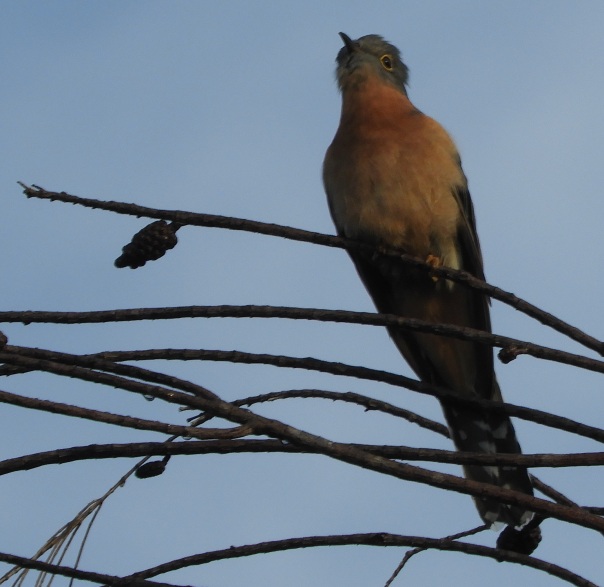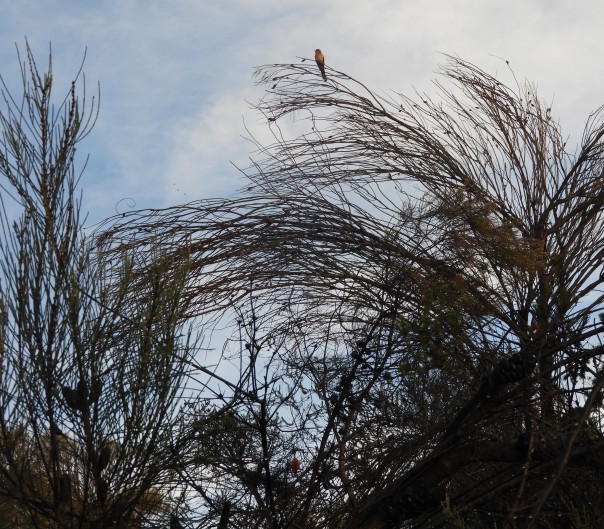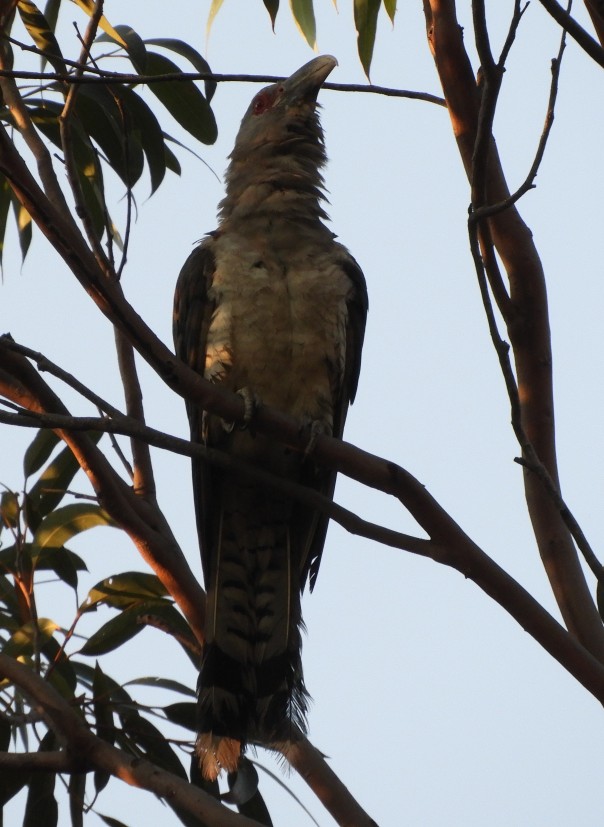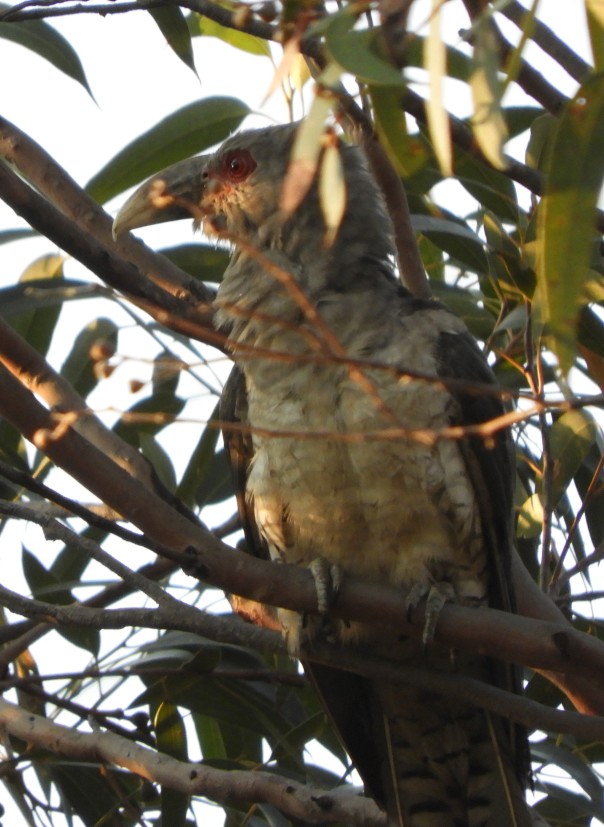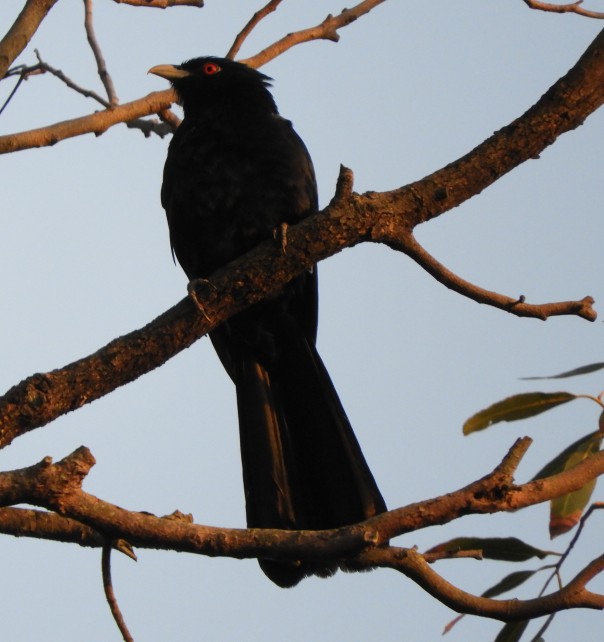Blog Archives
Big baby! Koel cuckoo fed by Red Wattlebird
It’s cuckoo season here on the east coast of Australia. We have several types of cuckoos that migrate to our shores for the summer months and get the local birds to feed their young. That’s right! Cuckoos lay their eggs in some other bird’s nest and fly away free as a … well, as a bird. The adoptive parent is often much smaller than the baby cuckoo, but it’s hornswoggled into feeding the youngster until the cuckoo is old enough to take care of itself.
One of the cuckoos that come to our shores is the Common Koel, also called the Eastern Koel. A couple of days ago, I saw a young Koel being fed by a Red Wattlebird:
In the video, you can hear the juvenile Koel chirping repeatedly, begging for food.
Here’s a photo of the big baby:

Adult Koels make quite a variety of sounds, including loud squawks and more melodic whistles. You can hear them in the video in this post. And you can see some shots of male and female adult Koels in other posts.
Common name: Common Koel, Pacific Koel, or Eastern Koel
Scientific name: Eudynamys orientalis (was scolopacea)
Approximate length: 45 cm
Date spotted: 3 December 2025 (summer)
Location: Manly Dam Park, New South Wales, Australia: 33°46’57.5″S 151°15’20.8″E
Two songs of the Fan-tailed Cuckoo
I’ve heard Fan-tailed Cuckoos several times over the years, making their pretty downward trilling call. A few days ago, I heard a different call: a haunting, mournful whistle sighing in the mist.
In this 14-second video, the bird whistles five times:
At first I didn’t know what type of bird was calling. Then I saw a Fan-tailed Cuckoo fly onto a nearby branch:

They’re rather pretty birds, with a russet chest and belly, and a startling orange mouth. On this occasion, I could see only the back of the bird. Here’s a picture of another Fan-tailed Cuckoo, which I saw in June 2020:
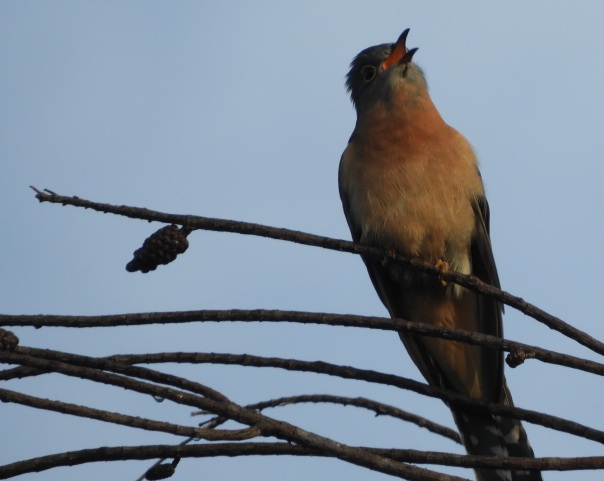
Shortly after I heard the whistles, the same bird or another started making the typical trilling call that I’ve heard more often. In this 17-second video, the bird calls four times:
Common name: Fan-tailed Cuckoo
Scientific name: Cacomantis flabelliformis
Approximate length: 26 cm
Date spotted: 11 May 2025 (autumn)
Location: Manly Creek, New South Wales, Australia: 33°46’21.3″S 151°14’34.8″E
Those dinosaur birds are back for the summer: Channel-billed Cuckoos
Channel-billed Cuckoos are large, strange-looking birds with red eyes, a large canoe-shaped beak, and a strangely apologetic way of moving around. These cuckoos migrate to Australia’s south-eastern coast in the warmer months, and they’ve just arrived for this year’s summer.

When provoked, Channel-billed Cuckoo’s make a reptilian hissing noise. With their red eyes and fierce beaks, and the prehistoric way that they move, they remind me that their ancestors were dinosaurs.

Like many other cuckoos, these birds lay their eggs in the nests of other birds, such as Currawongs, and leave the raising of their chicks to the adoptive parents.
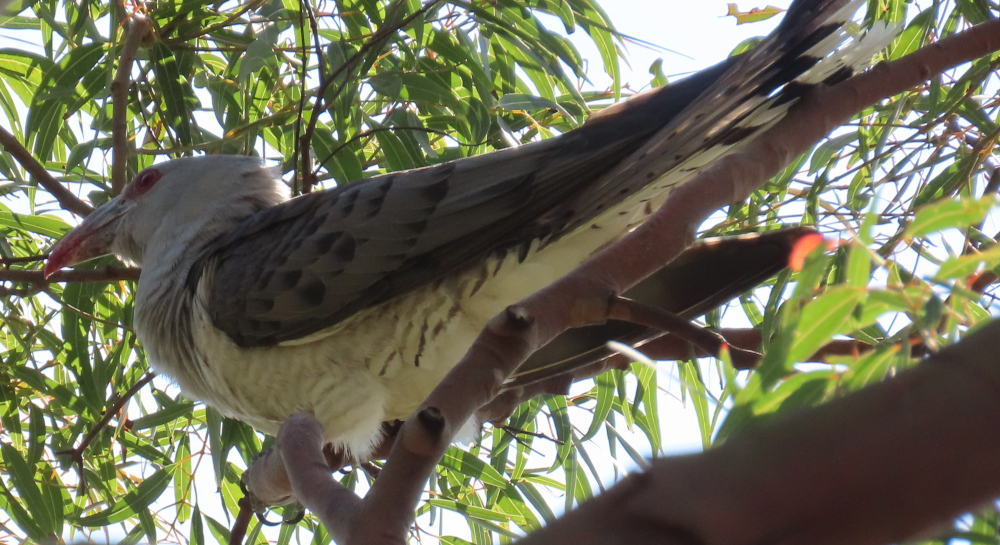
A Channel-billed Cuckoo’s life is not a peaceful one. Several other species do their best to chase the cuckoos out of the neighbourhood, to prevent them from hi-jacking nests. In this video, the cuckoo ducks the persistent swooping of Noisy Miners (hint: set the video quality to high definition for best viewing):
You can find out more about these birds in my other posts about cuckoos.
Common name: Channel-billed Cuckoo
Scientific name: Scythrops novaehollandiae
Approximate length: 58-65 cm
Date spotted: 22 September 2024 (spring)
Location: Allambie Heights, New South Wales, Australia
Koel cuckoo wearing the midnight
The Koel cuckoos are back! They migrate to our region of eastern Australia in spring, and go back up north in autumn. You know they’re there because of their loud call: coo-eee, coo-ee. It’s less often that you manage to see one, as they tend to stay high up in the trees and make use of the foliage to hide from other birds.
This male Koel spent a few minutes in a relatively exposed position on the street where I live:
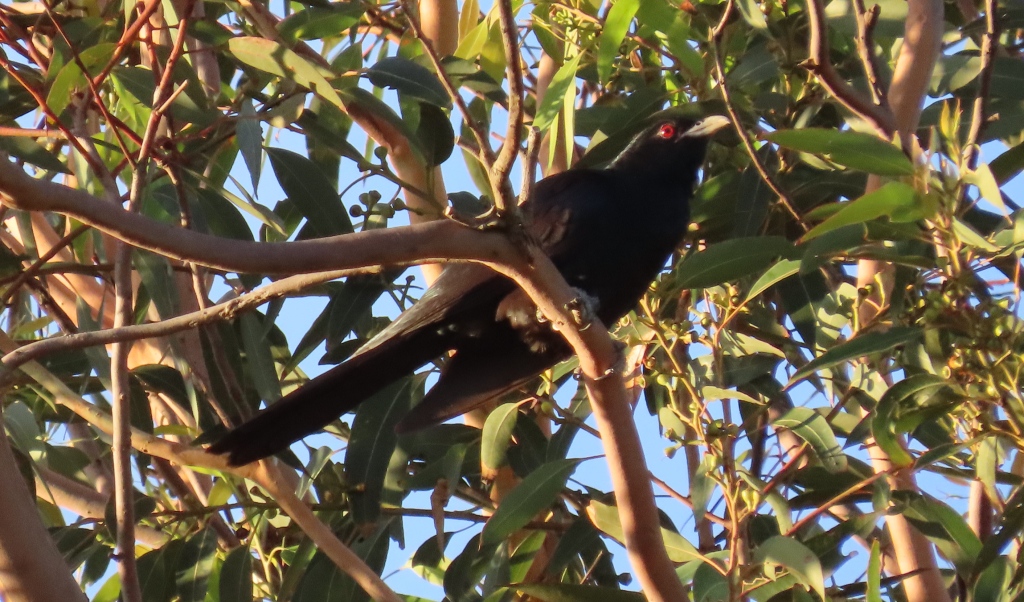
The males are entirely black, with bright red eyes and a pale beak. Like other cuckoos, the females lay their eggs in the nests of other birds (mostly wattle birds and friar birds). The cuckoo then abandons the egg and leaves it up to the foster parents to bring up the chick.
My earlier posts name this bird as a Common Koel (Eudynamys scolopacea). I’ve discovered recently that Koel cuckoos were recently reclassified as Pacific Koels (Eudynamys orientalis).
Common name: Pacific Koel or Eastern Koel
Scientific name: Eudynamys orientalis (was scolopacea)
Approximate length: 45 cm
Date spotted: 19 January 2024 (summer)
Location: Allambie Heights (north of Sydney) New South Wales, Australia
Baby Channel-billed Cuckoos fed by Currawongs
Walking along a shady path this morning, I heard a loud caterwauling from above. Two baby Channel-billed Cuckoos sat in the trees, yowling and shaking their wings. A Currawong arrived and fed a piece of meat to one of the cuckoos. Then another Currawong brought food to the second screeching youngster.
Like most cuckoos, Channel-billed Cuckoos lay their eggs in the nests of other birds and leave it to those other birds to hatch the egg and look after the growing chick. These particular cuckoos are very large (around 65 cm from head to tail) and so they need to pick the adoptive parents carefully. Currawongs are the usual choice.
This video shows one of the babies yowling and begging for food from its Currawong adoptive parent:
See how large the baby is in relation to the Currawong who’s looking after it! In the next video, one of the babies attempts to eat a largish morsel of meat that a Currawong has just fed to it:
I’ve never seen two babies together before. I wonder if they both came from the same nest, or if they found each other after leaving their nests?
Here’s a still picture of one of the baby cuckoos:
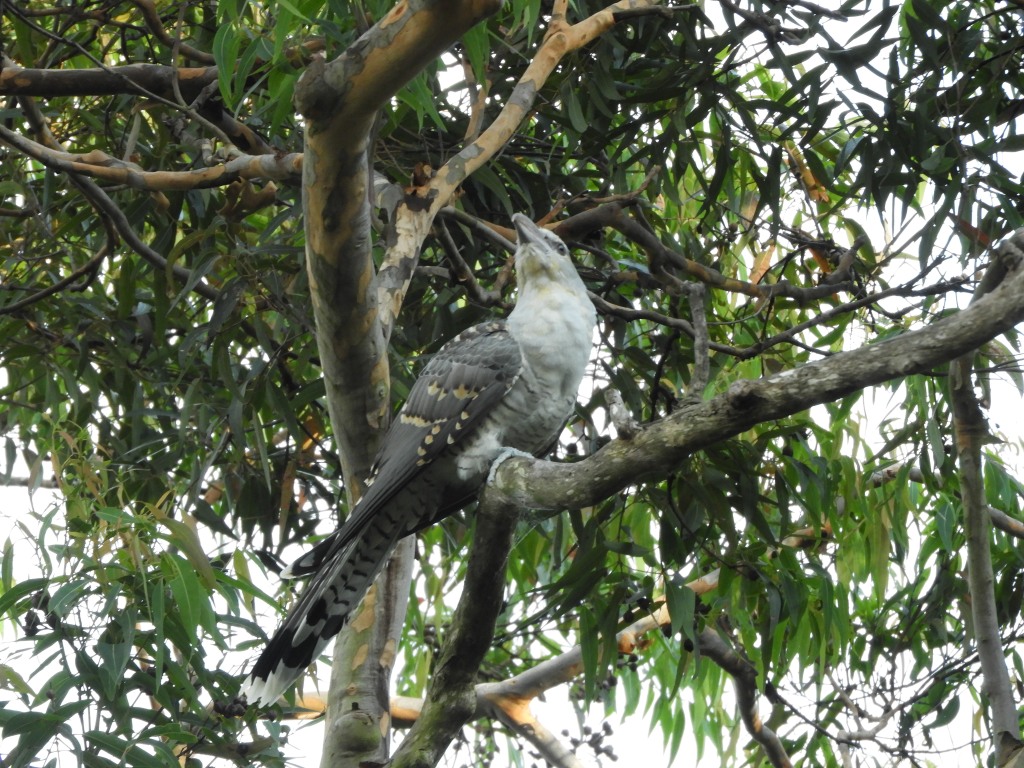
Being a youngster, its eyes are still light brown. The adult birds have fierce red eyes. They’re magnificently ugly birds.
In the next picture, one of the babies is pointing its beak at the sky, perhaps wondering where its next feed is coming from:
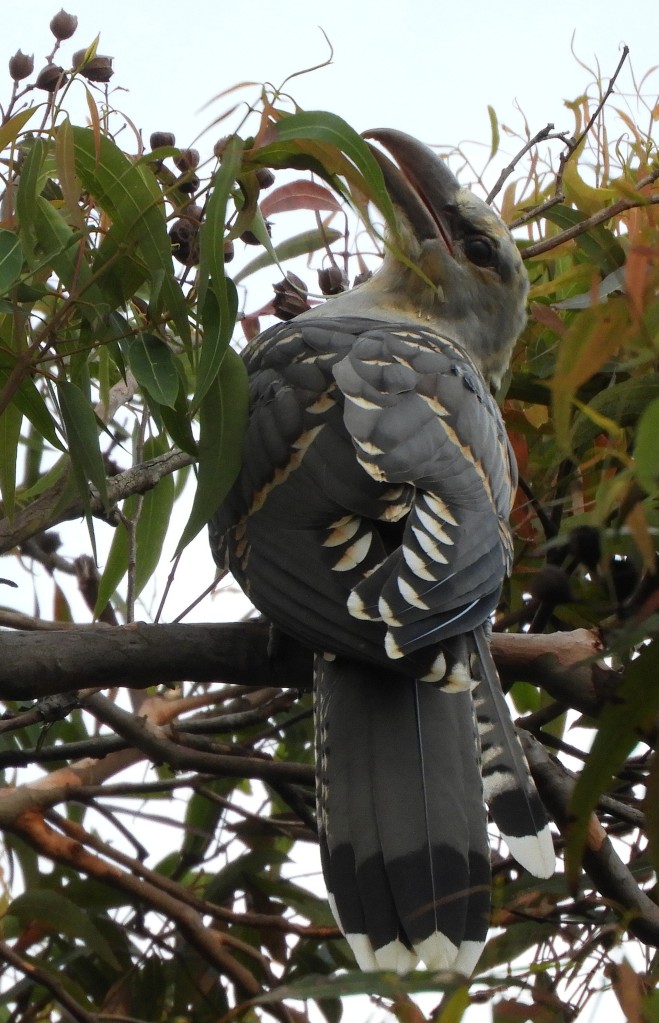
That picture gives a good view of the bird’s large beak and the markings on its back and tail.
One of the things you notice about Channel-billed Cuckoos is the supple way they move their neck and head. Here’s one of the babies leaning forward, in a pose that’s typical of these birds:
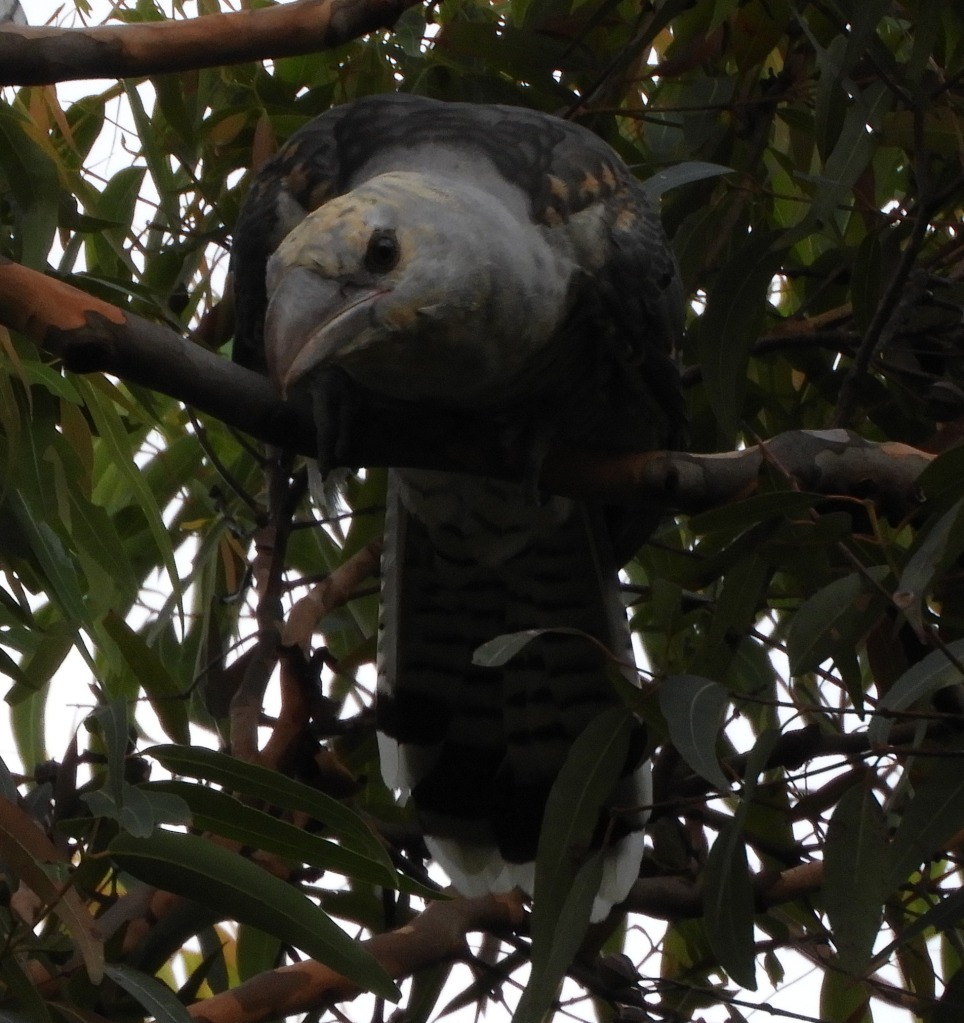
Oo-er, you probably wouldn’t want to bump into that bird one dark night. Here’s a picture of both baby cuckoos, looking at each other:

To finish off with, here’s a close up of one of the babies, head and neck only:

You can find out more about these birds in my other posts about cuckoos.
Common name: Channel-billed Cuckoo
Scientific name: Scythrops novaehollandiae
Approximate length: 58-65 cm
Date spotted: 18 December 2021 (summer)
Location: Manly-to-Spit Walk, Balgowlah, New South Wales, Australia: 33°48’00.9″S 151°15’54.9″E
Juvenile Channel-billed Cuckoo and female Koel Cuckoo
Today an unearthly caterwauling called my attention to a juvenile Channel-billed Cuckoo perched on a wire. It was crouched down, flapping its wings, and uttering harsh calls:

Even at this age, it’s a big bird. I’d guess it was already full size, at around 60 centimetres in length. A giant baby indeed. And one that needs a lot of feeding.
The youngster stretched out its neck and called even louder:

It peered up into the air expectantly:

I didn’t catch any pictures of the next stage, alas, because the bird flew to a leafy tree and was mostly hidden from view. I did see the dedicated proxy parent, a Currawong, feeding the youngster, accompanied by a frenzied gabbling noise from the demanding child.
Common name: Channel-billed Cuckoo
Scientific name: Scythrops novaehollandiae
Approximate length: 58-65 cm
Date spotted: 23 January 2021 (summer)
Location: Manly Dam Park, New South Wales, Australia: 33°46’06.4″S 151°14’52.6″E
In a nearby tree, a female Koel Cuckoo sat and watched the commotion:

Common name: Common Koel or Eastern Koel
Scientific name: Eudynamys scolopacea
Approximate length: 45 cm
Date spotted: 23 January 2021 (summer)
Location: Manly Dam Park, New South Wales, Australia: 33°46’06.4″S 151°14’52.6″E
Both Channel-billed and Koel cuckoos are parasitic cuckoos, which means that they lay their eggs in the nests of other birds, and leave it up to those other birds to feed and care for the youngsters. Bot cuckoo types are migratory, coming down to this part of Australia for the warmer summer months, then heading to more northern countries for the winter.
Want to know more? I’ve posted some pictures and stories about previous encounters with cuckoos.
Channel-billed Cuckoo in our garden
It seems to me that the Channel-billed Cuckoos were late in arriving from their annual migration this year. Some people were pleased about that, as these birds make a tremendous noise in the early morning hours! But I was pleased when I eventually heard their raucous calls earlier this week.
Today, one dropped in on a tree in our garden. As usual, the other birds were harassing it.
Channel-billed Cuckoos are impressive birds. They have fierce red eyes and a large, hooked beak. Like many other types of cuckoos, they lay their eggs in the nests of other birds rather than making their own nests. They also leave the task of caring for the young birds to the substitute parents!
This particular cuckoo was a little wet and bedraggled. What with the rain and the harassment of the other birds, the cuckoo doesn’t seem to be enjoying life much.
Common name: Channel-billed Cuckoo
Scientific name: Scythrops novaehollandiae
Approximate length: 58-65 cm
Date spotted: 20 September 2020 (spring)
Location: Allambie Heights, New South Wales, Australia
Song of the Fan-tailed Cuckoo
Walking through the Aussie bush, I’m sometimes intrigued by a musical trill coming from the hidden depths of the forest. The sound starts high and drops rapidly down the scale to a lower pitch. Today, for the first time, I managed to spot the bird that makes this lovely noise: a Fan-tailed Cuckoo:
At first I thought it couldn’t be a cuckoo, because don’t all cuckoos leave for warmer climes when winter arrives on the Australian east coast? Evidently not. For the most part, Fan-tailed Cuckoos brave the cold weather, although those in Tasmania do move north into the mainland.
Here’s the cuckoo caught in mid trill:
Like other cuckoos, these birds lay their eggs in the nests of other species. Fan-tailed Cuckoos choose fairy-wrens and thornbills as their hosts. Such small little parents to raise a cuckoo!
Here’s another shot of the bird, this time with its beak closed:
This particular bird has a lovely rich coloring. Other photos I’ve seen show less orange in the chest feathers, and a lighter grey on the head and back.
Singing again:
Fan-tailed Cuckoos feed on insects. Typical behaviour is to sit high up on a branch then swoop down when a meal crawls or flutters into view. Here’s a non-zoomed-in view of the bird:
Common name: Fan-tailed Cuckoo
Scientific name: Cacomantis flabelliformis
Approximate length: 26 cm
Date spotted: 13 June 2020 (winter)
Location: Manly Dam National Park, New South Wales, Australia: 33°46’29.5″S 151°14’46.3″E
Scruffy Channel-billed Cuckoo
Are you often woken up in the early hours of the summer morning by a hoarse hooting noise? It sounds like giants boasting about a joke they’ve played on the world. The call puts the Kookaburras to shame, in terms of melody (lack thereof) and loudness (excess thereof).
That noise is made by the Channel-billed Cuckoos. One of my earlier posts has a recording of the call. This picture shows a rather scruffy-looking example of these birds. It’s probably spent the night out on the town:
Channel-billed Cuckoos spend the winter in Papua New Guinea and Indonesia, then migrate southwards to Australia for the summer. We see them in the Sydney area from September through to March each year. The first time I hear their raucous call, I know that spring has arrived.
Like many cuckoos, these birds lay their eggs in the nest of another species. Often, the parent cuckoo breaks the eggs of the host birds. When the young cuckoo hatches, the luckless host parents then feed and protect the cuckoo chick until it’s ready to leave the nest.
Channel-billed Cuckoos are large birds. Their appearance matches their call: Take no nonsense from no-one. Here’s a view of the bird’s head in profile, with that impressive red eye and hooked beak:
To see more pics and videos, check out my list of cuckoo posts.
Common name: Channel-billed Cuckoo
Scientific name: Scythrops novaehollandiae
Approximate length: 58-65 cm
Date spotted: 28 December 2019 (summer)
Location: Manly Dam Reserve, New South Wales, Australia: 33°47’00.6″S 151°15’10.1″E
Male Koel Cuckoo in shot at last
Recently I’ve managed to snap a few shots of female Eastern Koels, also called Common Koels or Koel Cuckoos. Now a male has come into my sights:
While the female is rather pretty, with shades of cream and brown overlaid with stylish spots, the male is primarily black. In fact, this photo shows more variation in colour than usual, because of the soft morning light.
If you’d like to see some shots of the females, or hear some of the cuckoos’ calls, take a look at this list of posts.
Common name: Common Koel or Eastern Koel
Scientific name: Eudynamys scolopacea
Approximate length: 45 cm
Date spotted: 28 December 2018 (Summer)
Location: Allambie Heights, New South Wales, Australia






